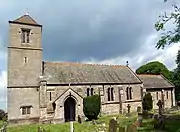Saint Hybald | |
|---|---|
| Saint | |
| Born | c. 664 |
| Died | c. 690 (aged 25–26) Hibaldstow, Lincolnshire, England |
| Venerated in | Catholic Church Western Orthodoxy |
| Canonized | Pre-Congregation |
| Major shrine | Hibaldstow (destroyed & rebuilt) |
| Feast | 18 September[1] 14 December (Orthodox)[2] |




Saint Hybald (fl. c. 664 – c. 690),[nb 1] also known as Higbald, Hibald or Hygbald, was a 7th-century Anglo-Saxon saint. His feastdays are 18 September and 14 December (Orthodox).
Life and legacy
The Venerable Bede, in his Ecclesiastical History, describes St Hybald as a "most holy and continent man who was an abbot in Lindsey".[5] It is conjectured, in the Dictionary of Christian Biography (1877–87), that this is the Benedictine abbey at Bardney,[6] then in the old Kingdom of Lindsey, now Lincolnshire.
In 679, Osthryth, queen of Mercia, sought to move the remains of her uncle, St Oswald, to Bardney,[7] but the monks refused to accept the body because Oswald, as king of Northumbria, had once conquered Lindsey. The remains were locked outside the abbey but the appearance of a mysterious beam of light, that night, led the monks to reconsider.[8]
Hybald was also a friend of Saint Chad, and, had a prophetic vision of his death.[6] He later, followed Chad's example and became a hermit.
Hybald died around 690,[4] and was buried in the village of Hibaldstow, whose name means place where St Hygbald is buried. Following his canonisation, a shrine was built near his grave to hold his relics, and became a place of pilgrimage. This continued until the English Reformation when the shrine was destroyed. Hybald's body remained undisturbed until it was rediscovered in 1864, when the, then, dilapidated church was rebuilt.[nb 2]
In addition to Hibaldstow, three Lincolnshire churches are dedicated to Hybald at Ashby de la Launde, Manton and Scawby.[3]
Notes
References
- ↑ "CatholicSaints.Info » Blog Archive » Saint Hygbald".
- ↑ "Hybald December 14".
- 1 2 David Farmer (14 April 2011). The Oxford Dictionary of Saints, Fifth Edition Revised. Oxford University Press. p. 84. ISBN 978-0-19-959660-7.
- 1 2 Matthew Bunson; Stephen Bunson (2003). Our Sunday Visitor's Encyclopedia of Saints. Our Sunday Visitor Publishing. p. 404. ISBN 978-1-931709-75-0.
- ↑ Bede 'Ecclesiastical History of the English People' Book 4,[A.D. 669]
- 1 2 David Farmer (14 April 2011). The Oxford Dictionary of Saints, Fifth Edition Revised. Oxford University Press. pp. 219–. ISBN 978-0-19-959660-7.
- ↑ Catholic Encyclopedia: St Oswald
- ↑ Bede. . Historia ecclesiastica gentis Anglorum. (as Leo Sherley-Price (trans.) (2008). The Ecclesiastical History of the English People. Penguin Classics. Penguin. p. 160.)
- ↑ Historic England. "St Hybalds, Hibaldstow (63488)". Research records (formerly PastScape). Retrieved 23 March 2013.